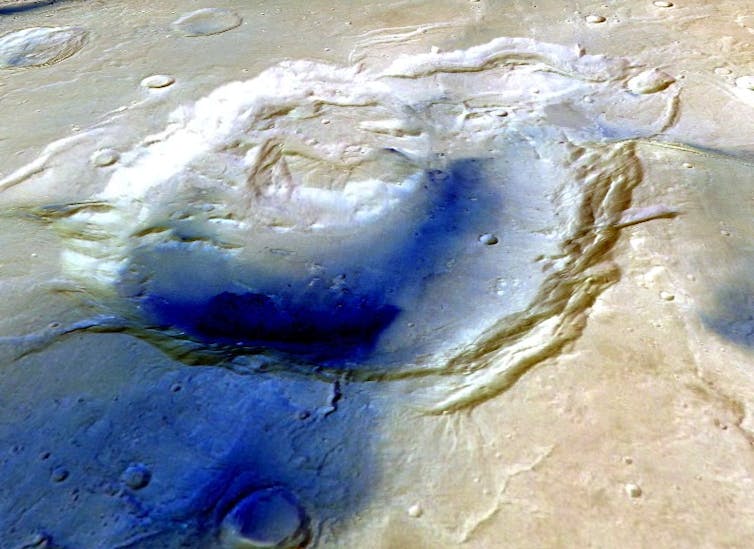Explosive eruptions from “supervolcanoes” may have changed the climate on ancient Mars, according to a study by the Planetary Science Institute (PSI).
The study, published in the journal Nature, found irregularly-shaped craters with features that challenge our understanding of the evolution of Mars’ geology and climate, and suggest a whole new class of volcanoes.
Joseph Michalski, scientist at the PSI in Tucson, Arizona, and lead researcher of the study, used high-technology imaging techniques to identify and map structural collapse features (such as calderas) in the terrain of Arabia Terra (an ancient, cratered part of the planet) that surrounds giant shield-style volcano vents.
After studying the geomorphology of what was thought to be impact craters, Dr Michalski discovered that some of these sites are, in fact, huge calderas - collapsed volcanoes.

“Many Martian volcanoes are easily recognised from their massive shield-shaped structure, similar to what we see in Hawaii,” said Dr Michalski. “But these are relatively youthful features on Mars and we have always wondered where the ancient volcanoes are. It is possible that the most ancient volcanoes were much more explosive and formed structures similar to what we now see in Arabia Terra.”
Arabia Terra, located in the northern highlands of Mars, has vast deposits of layered, fine-grained materials of an unknown origin. Although it had been suggested before that these deposits could have come from explosive volcanism, no volcanoes were ever found in the region until now.
Dr Michalski uncovered a unique set of features, called plains-style caldera complexes, which were made up of:
- collapse features
- low topographic relief (such as lower than a typical patera)
- plains-style lavas
- fine-grained, layered deposits.
This led Dr Michalski to introduce a new category of volcanic construct. Astrogeologists have already identified a few examples of other such volcanoes on Mars - Eden Patera, Siloe Patera, Euphrates Patera, Ismenia Patera and Oxus Patera.

“We have shown evidence for a new type of volcano on Mars - supervolcanoes that were incredibly explosive and operated in the first billion years of Mars’ history,” said Michalski. “These volcanoes might be the source for many of the layered sediments found on Mars - those sediments might be ash deposits from volcanoes. These eruptions also would have been important for understanding the origin of the martian atmosphere, which formed from volcanic outgassing.
"Scientists have always expected that ancient volcanoes exist on Mars, but we have not been able to find much evidence for ancient volcanism. One possible reason why, and the reason most people have embraced, is that the evidence was erased by erosion. But, another distinct possibility is that they most ancient volcanoes look different from the younger ones, and so we were looking for the wrong kind of feature.
"We think both aspects are important, but the hypothesis we present in this paper is that perhaps many ancient volcanoes were simply more explosive and therefore have not been recognised because they do not form the same kind of volcanic structure as the younger ones.”
“What Michalski has done is to take another closer look at observations that were made some time ago,” said Simon Redfern, Professor of Mineral Physics at the University of Cambridge, and who was not involved in the study. “The interpretation he has made is a revision of the previous assumptions about the origins of these craters, re-classifying them as catastrophic events originating from deep within the planet, rather than from without.
"Recent measurements like those of [Curiosity Rover](http://en.wikipedia.org/wiki/Curiosity_(rover) and the Mars Explorer Rovers have identified the nature of some of the sediments at Mars’ surface, and point to a possible explosive volcanic origin for, which has spurred folks to look again more carefully for evidence of the source in the landforms of the planet.
"The suggestion that some craters are not, in fact, impacts but instead are large collapsed volcanoes will doubtless lead to further re-analysis of earlier observations and possible future reinterpretations. We are beginning to get reliable geochemical data from the surface of the red planet, and as it accumulates we can expect that some of the earlier assumptions will be questioned and re-opened for new interpretations like this.”
Jonathan Clarke, president of Mars Society Australia, believes the new findings are important because they introduce a whole new class of volcanic processes on Mars that fills in planetary evolution knowledge gaps.
“These eruptions suggest that at least some of the earliest volcanic eruptions on Mars were very rich in volatiles like water and carbon dioxide, much richer than some later eruptions,” said Dr Clarke, who was also not involved in the study. “These findings may bring us closer to understanding why Mars is no longer the dynamic planet it once was. We can now get a clearer picture of how a wet planet with a thick atmosphere and an active hydrological cycle dried out.”
Dr Michalski agreed, believing that it is important to learn and understand all the styles and phases of volcanism on Mars and how they might have affected the Martian climate through time.
“We hope that this discovery will open a new window into the most ancient Martian history - revealing how ancient volcanism might have differed from what we already understood about younger activity,” he said. “It provides new evidence for possible sources of interesting sedimentary deposits. It demonstrates how massive, explosive eruptions would have contributed to the formation of the ancient atmosphere and also significantly perturbed the ancient climate.”
So what lies ahead for researchers after this?
“In the next stage of discovery, I would be interested to see how many more features can be found,” said Dr Clarke. “This study only covers a very small surface area on Mars. And now that we know of this new category of volcanoes on Mars, will we discover them on other planets as well?”

